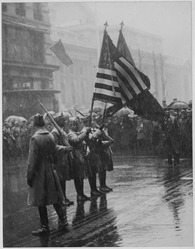| Date | 1896 |
|---|---|
| Location |
Nogales, Sonora Nogales, Arizona |
| Outcome |
Uprising suppressed ~3 killed |
| |||||
| |||||
| |||||
The Yaqui Uprising, or the Nogales Uprising, was an armed conflict that took place in the Mexican state of Sonora and the American state of Arizona. In February 1896 the Mexican revolutionary Lauro Aguirre drafted a plan to overthrow the government of President Porfirio Diaz. Aguirre's cause appealed to the local native Americans, such as the Yaqui, who organized an expedition to capture the customs house in Nogales, Sonora on August 12. During the battle that followed, several people were killed or wounded and the rebels were forced to retreat, ending the conflict after one encounter. It was also notable for being one of the final episodes of the American Indian Wars, due to the involvement of an American militia, from the adjacent town of Nogales, Arizona, and Buffalo Soldiers, who participated in an inconclusive pursuit of the hostiles.[1]
Uprising
The conflict began as result of the dictator Porfirio Diaz and his "anti-agrarian and anti-indigenous Mexican policies". Also, the Mexican Army and the Yaquis had been fighting an almost constant war against each other for several decades prior to 1896. The wars forced many of the natives to flee north into the American state of Arizona where they settled around Tucson and Phoenix, occasionally recrossing the border to fight the Mexican soldiers. Diaz was known for censoring critics in the media, which created unrest amongst the civilian population of Mexico and in the United States. At the town of Solomonville, in southern Arizona, the journalist Lauro Aguirre and Flores Chapa established the anti-Diaz newspaper "El Independiente" and on February 5, 1896, they wrote the "Plan Restaurador de Constitucion y Reformista". The plan claimed that Diaz had violated the Constitution of 1857 in multiple ways and was mistreating native Mexicans, particularly by deporting them to the Yucatan. It also proposed free elections and the use of force to overthrow the Diaz regime. The Yaquis and the Pimas were longtime enemies of Mexico so Aguirre had no trouble in recruiting local natives to help in the fight. In March 1896, the United States government arrested Aguirre and Chapa, because the Mexican consul accused them of conspiring to reenter Mexico and engage in revolutionary actions, but both of the men were acquitted in federal court after the American consul's investigation concluded that they were innocent of any wrongdoing. However, the plan was signed by twenty-three people, including Aguirre, and one other man believed to be Tomas Urrea, the father of the revolutionary Teresa Urrea. Because Tomas Urrea had close relations with many of the people involved in the uprising, Teresa Urrea was suspected of being the mastermind. There were at least seventy Yaquis, Pimas and Mexicans who participated in the raid. Many were employees of the Southern Pacific Railroad. They called themselves "Teresasitas" and their goal was to "capture the arms, ammunition, and money in the Mexican custom-house at Nogales."[1][2][3][4][5]
Nogales, Sonora, and Nogales, Arizona abut one another so on August 12, when the Teresasitas attacked, the Mexican consulate, Manuel Mascarena, requested aid from the Americans in or around Nogales, Arizona. A militia was hastily assembled on the Arizona side of the border and sent in to help rout the rebels during the battle and on the next day Brigadier General Frank Wheaton dispatched elements of the 24th Infantry. At least three men were killed in the fighting and several others were wounded but other sources claim that seven Mexicans died while the Teresasitas lost about the same amount. When the rebels retreated they were pursued by a posse of Sonoran policemen. The police eventually caught up with the Teresasitas later that day and fought another skirmish which left the Mexican commander dead. On the day after that, a large force of Mexican Army troops, under the command of Colonel Emilio Kosterlitzky, joined in the pursuit while two companies of the 24th Infantry conducted their own separate operations. Both of the pursuing parties failed to catch up with the rebels, a portion of whom dispersed to their homes in southern Arizona. After that there was no further conflict, the successful defense of Nogales was effective in suppressing the uprising. Aguirre continued to print and circulate news critical of the Diaz regime but in 1902 he was forced to leave his home in Mexico due the belief that Diaz was trying to kidnap him. Aguirre continued writing in the United States and he later attempted to take over the city of Ciudad Juarez but this plot was foiled. On September 11, 1896, Teresa Urrea publicly denounced having had anything to do with the uprising, but Porfirio Diaz held her responsible so he pressured the American government into moving Urrea from El Paso, Texas to Clifton, Arizona, away from the volatile border region.[1][2][3][4][5][6]
See also
- Yaqui Wars
- Garza Revolution
- Battle of Nogales (1913)
- Battle of Nogales (1915)
- Battle of Ambos Nogales
- Crawford Affair
- Crabb Massacre
References
- ↑ 1.0 1.1 1.2 Johnson, pg. 664-665
- ↑ 2.0 2.1 Garcia, pg. 173-176
- ↑ 3.0 3.1 Ruiz, pg. 97-117
- ↑ 4.0 4.1 URREA, TERESA | The Handbook of Texas Online| Texas State Historical Association (TSHA)
- ↑ 5.0 5.1 Garza, pg. 40-41
- ↑ Huachuca Illustrated, vol 1, 1993: Fort Huachuca: The Traditional Home of the Buffalo Soldier
- Garcia, Mario T. (1981). Desert Immigrants: The Mexicans of El Paso, 1880-1920. Yale University Press. ISBN 0-300-02520-3.
- Ruiz, Vicki; Virginia Sánchez Korrol (2005). Latina legacies: identity, biography, and community. Oxford University Press. ISBN 0-19-515399-5.
- Johnson, Alfred S.; Clarence A. Bickford (1896). The Cyclopedic review of current history, Volume 6. Garretson, Cox & Co.
- Garza, Hedda (1994). Latinas: Hispanic women in the United States. University of New Mexico Press. ISBN 0-8263-2360-X.
| |||||||||||||||||||||||||||||||||||||
The original article can be found at Yaqui Uprising and the edit history here.
